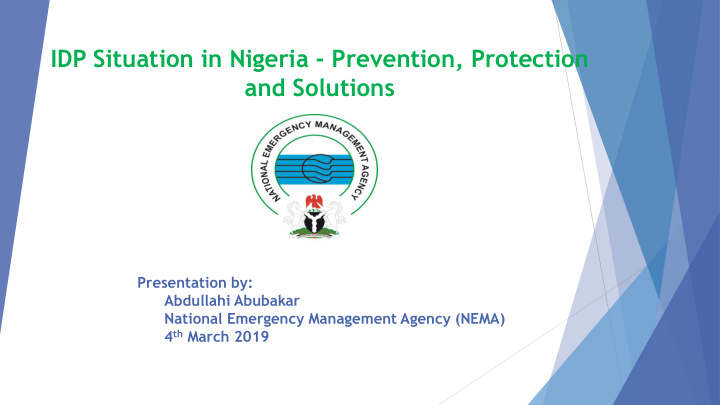



IDP Situation in Nigeria - Prevention, Protection and Solutions Presentation by: Abdullahi Abubakar National Emergency Management Agency (NEMA) 4 th March 2019
Nigerian Population Statistics Population: 190,900,000 (2017) IDP (conflict) Population: 2,026,602 (Oct 2018) IDP (Flood) Population: 722,741 (Oct 2018)
National Emergency Management Agency (NEMA) Established in 1999 NEMA is responsible for the management of disaster and coordination of national disaster response. Coordination framework of NEMA
Causes of Displacement in Nigeria Communal Clashes Flood Insurgency
A History of Displacement in Nigeria 2012 – Floods Unprecedented floods in 33 states Affected a over 7 million people were affected and over 2 Million people were displaced. This lead to the development of the national contingency plan and adaption of sectorial response in disasters Establishment of NEMA Situation room: The Disaster Situation working group was established at the pick of the flood disaster that ravaged about 32 states across the country in 2012, this action is informed by the need for urgent information and immediate intervention by NEMA management. However, the group was initially limited to gather data on flood disaster only but now works extensively to cover other areas of disaster 2014 – Insurgency The North Eastern States and some states in Nigeria witnessed unprecedented insurgency and conflict from 2009 to date, leading up to the declaration of state of emergency in Borno, Yobe and Adamawa States in 2013. The escalation of violence caused by the Boko Haram insurgency led to an increase in the number of Internally Displaced Persons (IDPs), especially in Adamawa, Bauchi, Borno, Gombe and Taraba States with a total of 868,335 IDPs estimated to have been displaced by December 2014.
Types of Settlements and long term effects NEMA identified Three types of IDP settlements which are as follows: Formal Camps Informal Camps/Settlements Host communities
NEMAs Approach Displacement NEMAs response to dealing with the IDP was adapted from the National Contingency Plan which made use of the Sectorial approach as such the following key sectors were establish: WASH Food and Nutrition Health Education Protection Shelter and NFI CCCM
Displacement Tracking Matrix In an effort to ensure accurate, uniform and acceptable IDP data collection NEMA and IOM collaborated on the DTM exercise since round 1 of the DTM, The DTM is currently on round 25 The DTM which started with 5 (excluding Borno) North eastern states in Nigeria, it was expanded from by round 9 to cover seven State of the North West and 6 States of the North Central and the FCT Abuja. The DTM exercise was however revised to cover only 6 states of the North east due to return of normalcy and subsequent return of the IDPs back to their homes. Data sources - State Emergency Management Agency(SEMA) , Data collectors, camp profiling, NRCS, local informants.
DTM Methodology Local Government area (LGA) level location assessment Ward/village level location assessments Site ‐ Camp assessments
NEMA and IOM staff during DTM in Bauchi State NEMA and IOM staff with community leader in Bauchi State
2018 Flood 12 Frontline states 129 Local Government Area Affected Affected Population 2,321,592 IDP Population 722,741 (Oct 2018) Biometric profiling in camps Short term camps Affected population/population in need
Protection Unaccompanied Manors Adoptions Reunion with Relatives Safe returns and re-displacements Community Stigmatization Over concentration of Efforts
Data Collection Issues Data collection and Unmeet Needs Economic Migrations by IDPs Exaggerated figures
Solutions Resettlement Comprehensive IDP data and information Responding to needs IDPs and livelihood solutions Inclusive Data collection coverage
Thank You
Recommend
More recommend